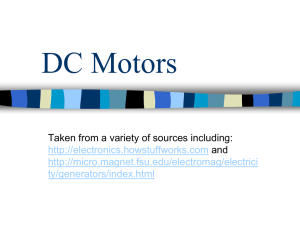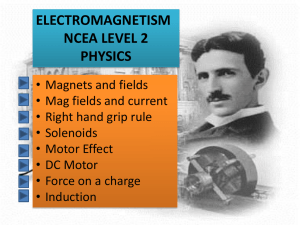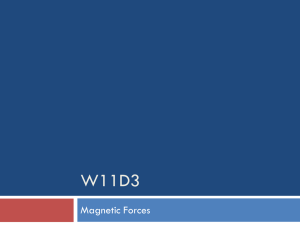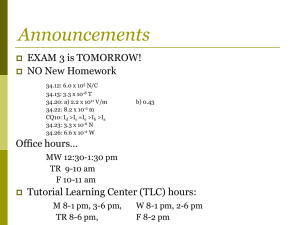Magnetism I - Galileo and Einstein
advertisement
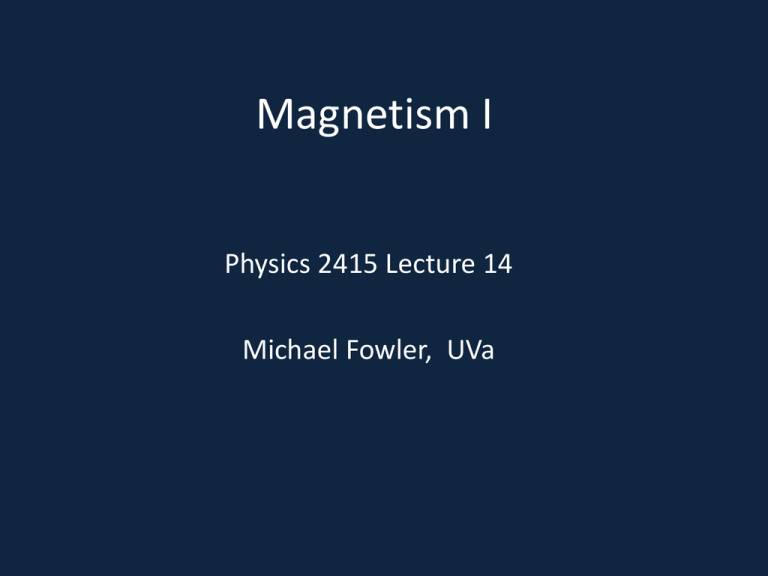
Magnetism I Physics 2415 Lecture 14 Michael Fowler, UVa Today’s Topics • • • • A bit more about RC circuits… Magnets and compasses Magnetic fields from electric currents Force on an electric current in a magnetic field Neon Tube Oscillator • Another old fashioned circuit, but a good illustration of capacitor charging. The power supply is 80 to 100V. • The neon tube is an insulator until the voltage across it reaches a critical value, below 80V, at which point the neon ionizes and becomes a good conductor, discharging the capacitor rapidly. • The cycle repeats: a flashing light! In the first moments after the battery is connected, there is a big voltage drop IR1 across R1. As the capacitor charges and the current drops, the voltage across the neon tube builds up. After the capacitor discharges through the neon, the recharge again gives voltage drop across R1. Magnets 101 Neodymium magnet The magnetic field of a bar magnet orients iron filings Clicker Question • Which is the most magnetic atom in the Periodic Table? A. Iron B. Cobalt C. Nickel D. Neodymium E. Dysprosium Answer: Dysprosium! • But it’s pretty rare: only 100 tons a year produced, all in China…and the Chinese are cutting back exports. • Meanwhile (from Wikipedia) • Neodymium-iron-boron magnets can have up to 6% of the neodymium substituted with dysprosium[20] to raise the coercivity for demanding applications such as drive motors for hybrid electric vehicles. This substitution would require up to 100 grams of dysprosium per hybrid car produced. Based on Toyota's projected 2 million units per year, the use of dysprosium in applications such as this would quickly exhaust the available supply of the metal. Earth’s Magnetic Field is approximately that of a bar magnet almost (but not quite) aligned with the axis of rotation. • The S pole is under the Arctic—so a compass N pole points appropriately. At the Earth’s surface, the magnetic field is approximately horizontal only near the equator. The inclination to the horizontal is the dip angle: 90 at the magnetic poles. Clicker Question • Where does the Earth’s magnetic field come from? A. The Earth has a core of iron, and it is a giant magnet. B. From electric currents circulating in the molten material in the Earth’s outer core C. From the radiation belts high in the Earth’s atmosphere Clicker Answer • Where does the Earth’s magnetic field come from? • From electric currents circulating in the molten material in the Earth’s outer core, driven by a combination of convection and Corioli’s forces. • Although the core is iron, iron becomes nonmagnetic above 1043K (the Curie temperature). Magnetic Seabed Stripes • In the cold war (1950’s) to better • . detect submarines magnetically, a detailed map of seabed magnetization in the Atlantic was made. It revealed a pattern of stripes of reversed magnetization, symmetric about the midatlantic ridge. • This explained continental drift: hot materials well up at the ridge, get magnetized as they cool in the Earth’s field, spread out both ways. And, the Earth’s magnetic field sometimes reverses, about every 300,000 years. Oersted’s Great Discovery • Born 14 August 1777, a day celebrated by Google! • In 1820, he was the first to show that electricity and magnetism were connected, by detecting the magnetic field of an electric current: it circled around, direction given by the right hand rule. Currents in Loops and Solenoids • Bending the wire into a circle, we can see the general shape of the field. Note that a solenoid (a series of connected loops) has a field resembling a bar magnet—but now we can see inside, notice there are no poles. • Magnetic lines of force don’t end anywhere: there are no single “magnetic charges”, monopoles. • The field direction is the way a compass needle (“dipole”) points. Force on Horseshoe Magnet from Current in Wire • A wire carrying an electric current is placed between the poles of a horseshoe magnet as shown. What force does the magnet feel? We’ve put in the relevant field line: the N pole is pulled upwards, and so is the S pole! • From Newton’s third law, the wire feels a force downwards. • . Wire carrying current perp into screen N S Force on Current in Wire from Horseshoe Magnet • Now turn this around, and consider • . the force on the wire as being from the magnetic field of the magnet. • From N’s third law, the force is downwards: perpendicular both to N the wire and to the magnetic field. • The magnetic field strength B is defined by this force: for a uniform field, straight wire length , F I B Wire carrying current perpendicular into screen S Force on Straight Wire Carrying Current in Constant Magnetic Field • It is well established experimentally that F I B is true for any angle between the wire and the constant field direction. In particular, a wire parallel to the field will feel zero force. • This equation fixes the unit of magnetic field: for F in Newtons, I amps, B is in Teslas. Force on Any Wire in a Constant Field • It is found experimentally that the total • . d 1 a d magnetic force on any wire carrying current I in a constant magnetic field B is the sum of terms d F I d B from rab each small segment d of the wire. • For a constant magnetic field B there is d a simple result : the total force on any b piece of wire going from a to b is the same as on a straight wire from a to b: b F I d B Irab B a 2 n b d a is just the sum of the little vectors!


